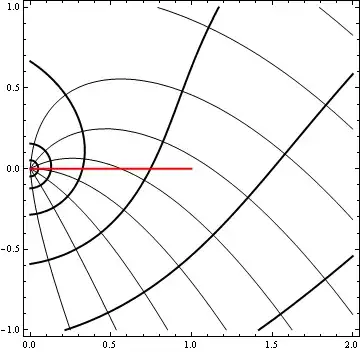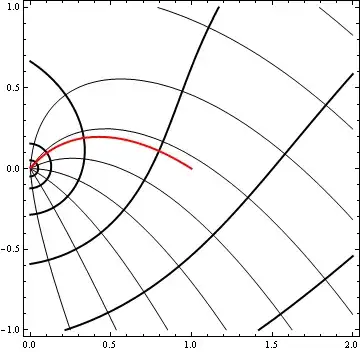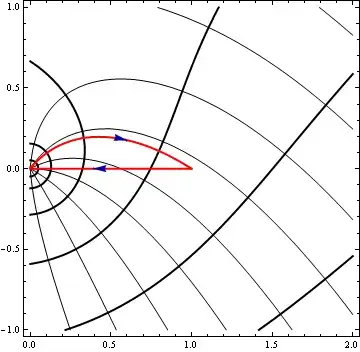The integral I'm trying to study is
$$ F(n) = \int_0^1 \exp\left\{n(t+\log t)+\sqrt{n}wt\right\}\,dt, \tag{1} $$
where $w$ is a fixed complex number with $\Re(w) < 0$ and $\Im(w) > 0$. As I'll indicate below, I "expect" an asymptotic expression of the form
$$ F(n) \sim A e^{n+\sqrt{n}w} n^{-1}. $$
My first attempt at estimating $(1)$ was to try to address the problem of the oscillatory integrand. I set out to mimic the method of steepest descent and deform the contour of integration so that the imaginary part of the argument $f(n,t) = n(t+\log t)+\sqrt{n}wt$ was constant.
The image below shows where $\Re(f(n,t)) = \text{const.}$ (thick lines), where $\Im(f(n,t)) = \text{const.}$ (thin lines), and the interval $(0,1)$ (red line). The parameter $n$ has been fixed at $10$.

By Cauchy's theorem I can deform the contour $(0,1)$ to the contour $C_n$, on which
$$ \Im(f(n,t)) = \sqrt{n}\Im(w), $$
shown in red below.

Thus I have
$$ \begin{align} F(n) &= \int_{C_n} \exp\left\{n(t+\log t)+\sqrt{n}wt\right\}\,dt \\ &= \int_{C_n} \exp\left\{\Re\left(n(t+\log t)+\sqrt{n}wt\right) + \sqrt{n}\Im(w)\right\}\,dt \\ &= e^{\sqrt{n}\Im(w)} \int_{C_n} \exp\left\{n(\Re(t)+\log |t|)+\sqrt{n}\Re(wt)\right\}\,dt, \end{align} $$
so that at least now I'm dealing with a real integral. However, I don't know where to go from here. It's clear that $C_n \to (0,1)$ as $n \to \infty$, so I think the last integral above could be asymptotic to
$$ \int_0^1 \exp\left\{n(\Re(t)+\log |t|)+\sqrt{n}\Re(wt)\right\}\,dt = \int_0^1 \exp\left\{n(t+\log t)+\sqrt{n}\Re(w)t\right\}\,dt, \tag{2} $$
but I don't know how to bound the "error"
$$ \int_{E_n} \exp\left\{n(\Re(t)+\log |t|)+\sqrt{n}\Re(wt)\right\}\,dt, $$
where $E_n$ is the closed loop $C_n \cup -(0,1)$, shown below.

If this error is sufficiently small, I could see if I could apply the general ideas of the standard Laplace method to the real integral $(2)$, though it's not of the usual form. My guess would be that
$$ \int_0^1 \exp\left\{n(t+\log t)+\sqrt{n}\Re(w)t\right\}\,dt \sim A e^{n+\sqrt{n}\Re(w)} n^{-1} $$
since the largest contribution to the integral comes from a neighborhood of $t=1$.
Any help would be greatly appreciated.